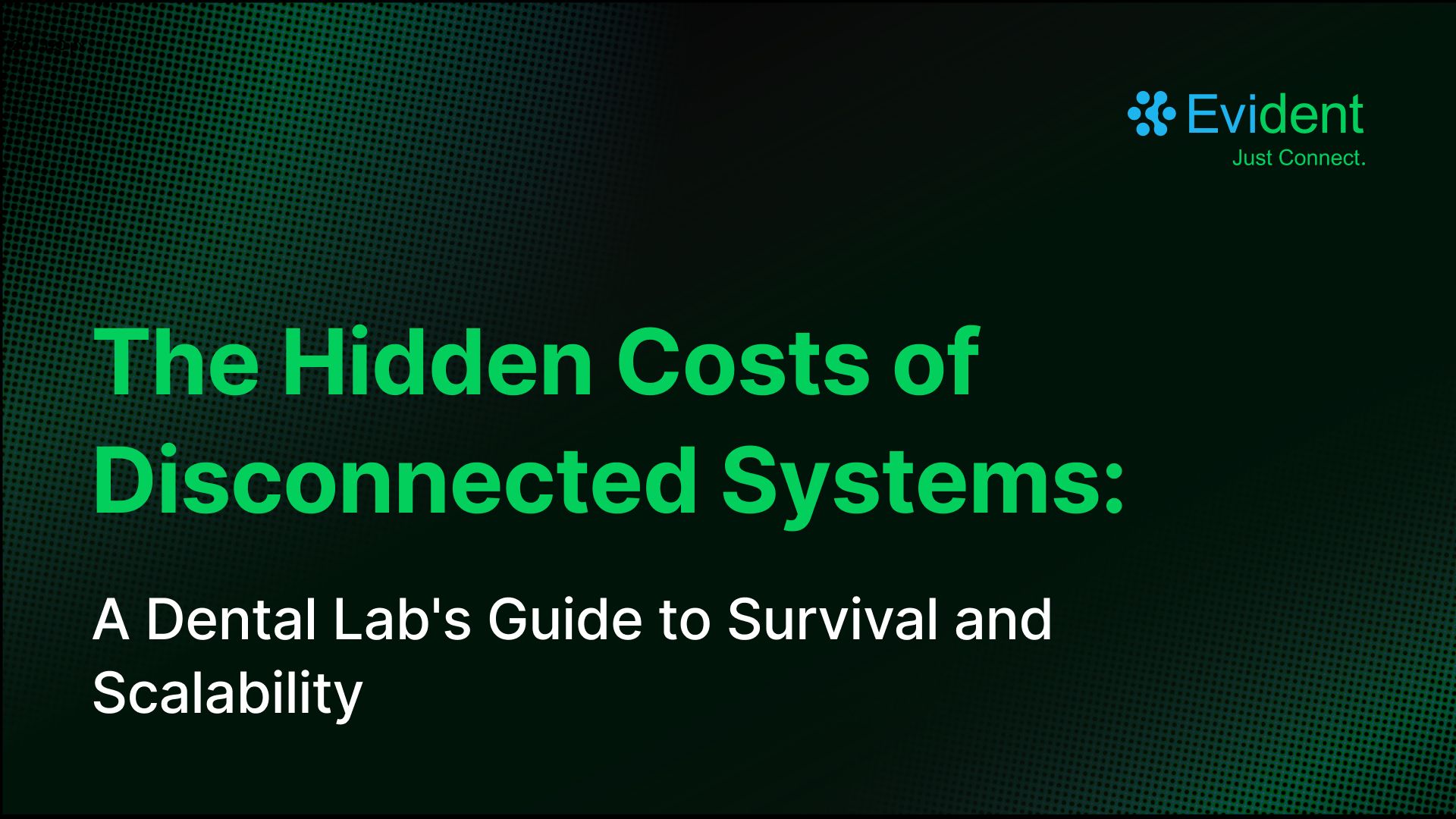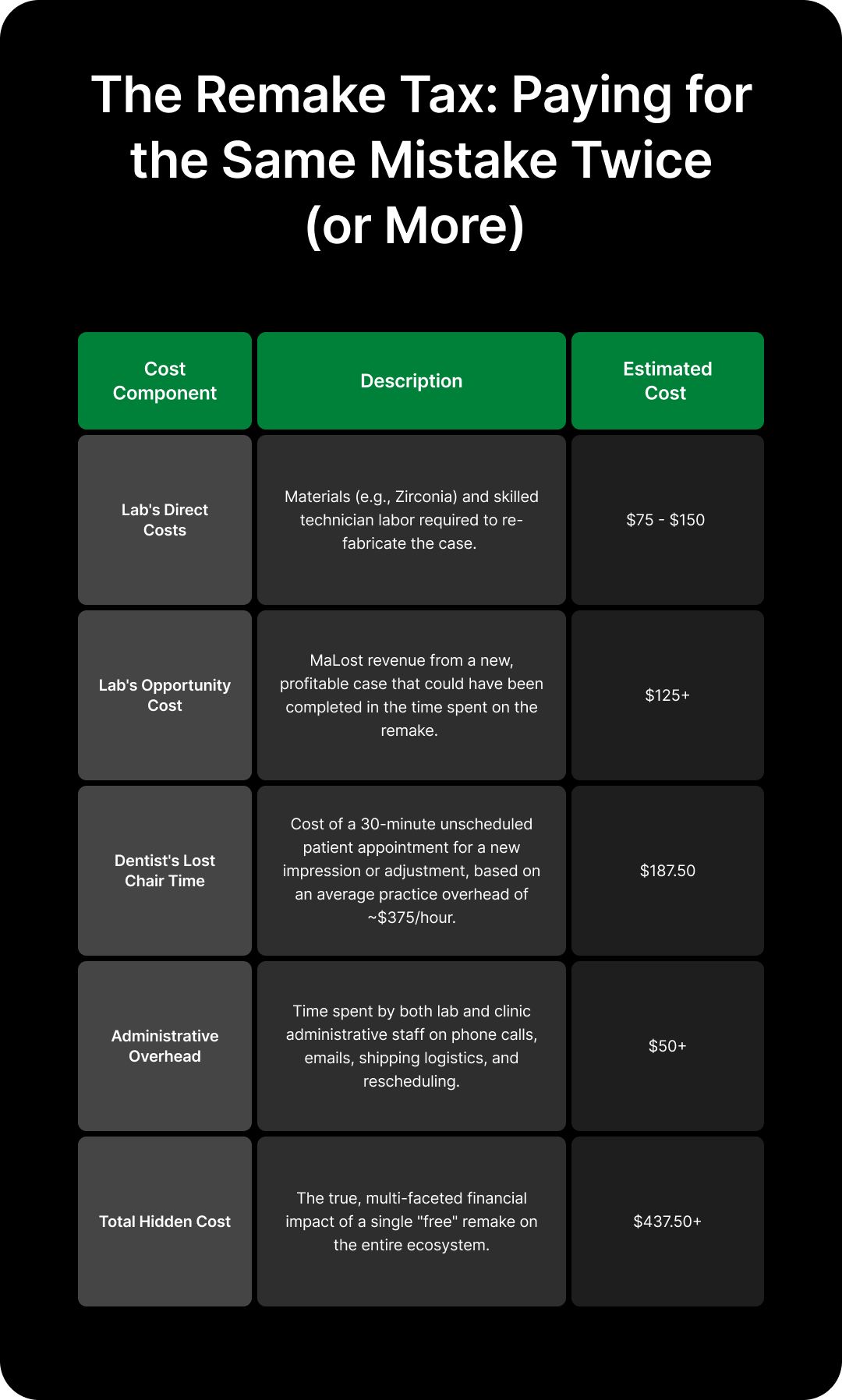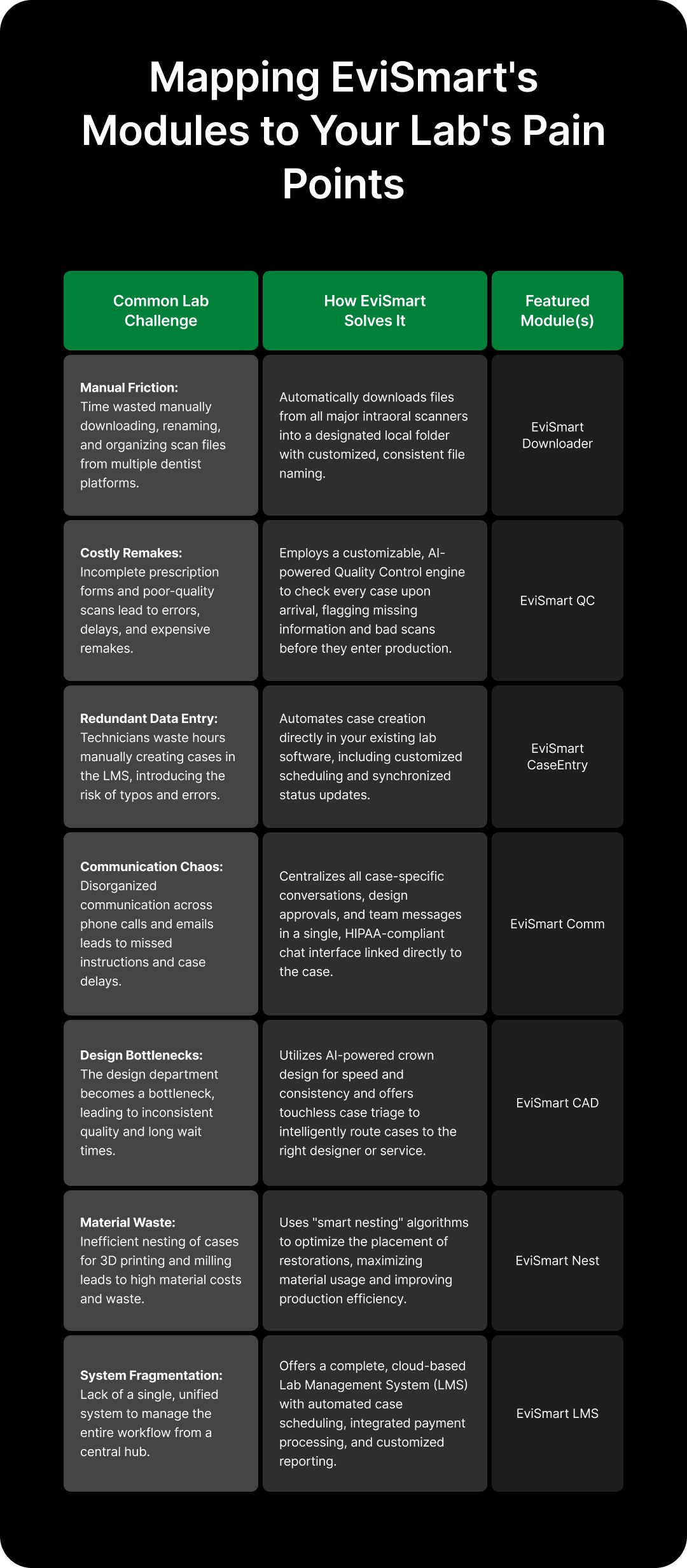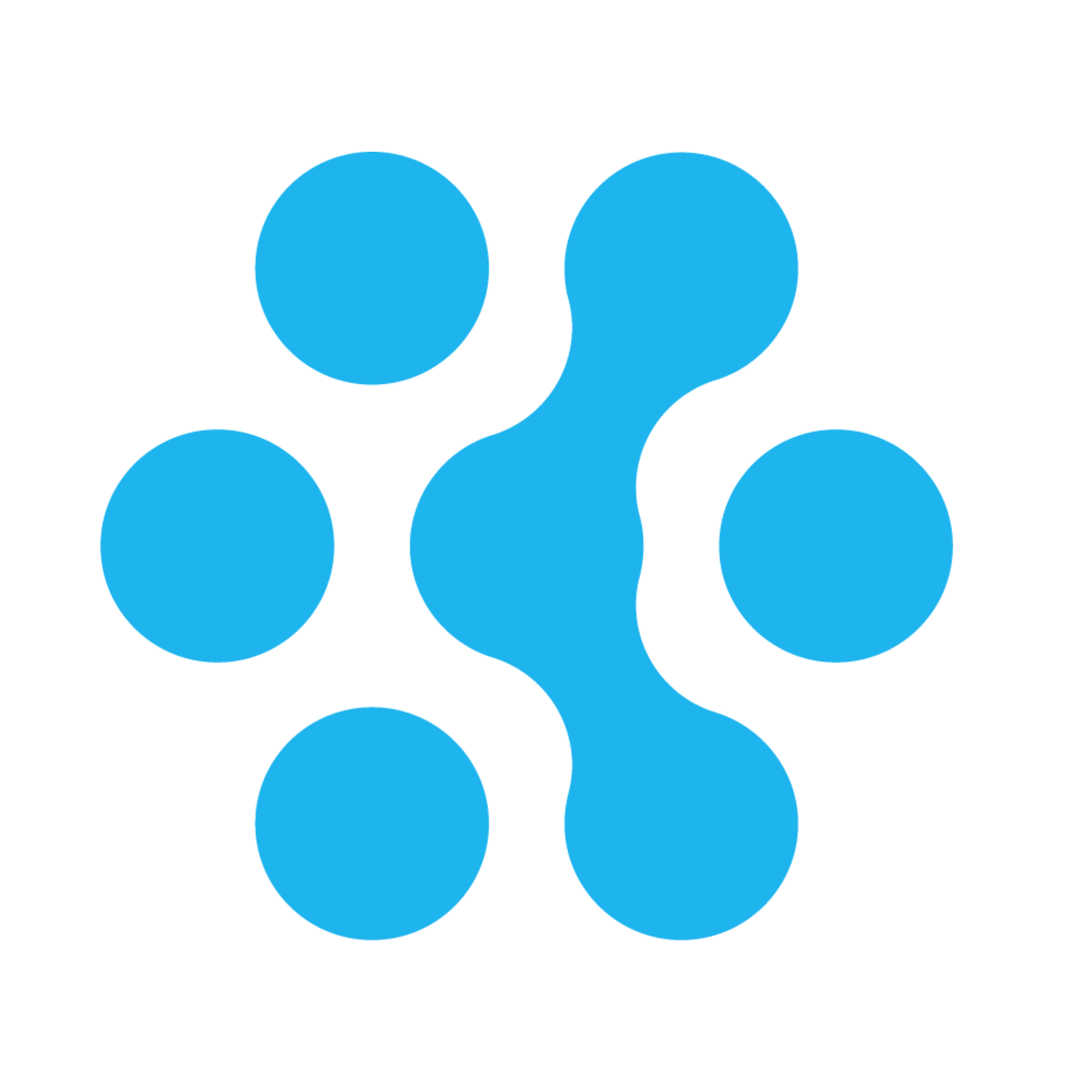The Hidden Costs of Disconnected Systems: A Dental Lab's Guide to Survival and Scalability

Introduction: The Anatomy of "Work Friction"
For many dental lab owners, the current technology landscape is a patchwork quilt stitched together out of necessity. Prescriptions arrive as a mix of emails, PDFs, and handwritten notes as well as IOS Scans from different portal. A technician/admin then manually transcribes or transfers this information into a Laboratory Management System (LMS). Case progress is tracked in a spreadsheet, if not simply in the head of a senior manager. Invoicing is handled later, through an entirely separate accounting program. This setup was never intentionally designed; it evolved, one tool at a time, to solve immediate problems.
This ad-hoc collection of tools and processes, however, creates a state of constant, low-grade operational drag. This is not merely an inefficient workflow; it is "work friction." This friction is a silent drain on profitability, a powerful catalyst for employee burnout, and arguably the single greatest barrier to scaling a modern dental laboratory. The pressures of a growing market only amplify these issues. The U.S. dental laboratories market was valued at USD 7.06 billion in 2023 and is projected to grow at a compound annual growth rate of 6.32% through 2030. This growth means more cases, more complexity, and more opportunities for a fragmented system to fail. This report will dissect and quantify the hidden costs of this work friction, revealing the true price of running on disconnected systems and outlining a strategic path from survival to scalability.
Section 1: The Hero Bottleneck: Why Your Best Technician is Your Biggest Risk
At the heart of many dental labs is a hero—a senior technician or production lead who seems to hold the entire operation together. They are the human bridge connecting the lab's disconnected systems, the one who "knows how everything works." While celebrated as an invaluable asset, this individual represents one of the most significant threats to a lab's stability and growth: Key Person Dependency.
1.1. Defining Key Person Dependency in the Lab Context
Key Person Dependency Risk is the potential negative impact on an organization that relies too heavily on a few individuals for its critical operations, knowledge, and relationships. This risk is not abstract; it is a tangible liability that manifests when a company becomes overly reliant on an employee who possesses unique skills or institutional knowledge that is not documented or shared. In the dental lab, this key person is often the most experienced technician. They are tasked not only with high-skill fabrication but also with the manual, repetitive work of bridging information gaps: retyping prescription data, chasing dentists for missing details, and catching errors before they cascade through the production line.
This is a widespread vulnerability. A 2023 study by the Society for Human Resource Management (SHRM) found that 72% of companies reported having at least one employee whose sudden departure would significantly disrupt their operations. In a dental lab, this dependency concentrates critical processes and decision-making into a single point of failure, making the business fragile and difficult to manage.
1.2. The Domino Effect of a Single Point of Failure
The operational risks of relying on a "hero" technician become starkly apparent the moment they are unavailable. When this key person is sick, on vacation, or resigns, workflows can slow to a crawl or stop altogether. Because critical processes are not documented, other team members are left without the information needed to proceed, leading to confusion, mistakes, and missed deadlines.
This dependency creates a persistent decision bottleneck. The key person is constantly interrupted by colleagues who need their approval or knowledge to move forward with tasks. This not only pulls the senior technician away from their most valuable work—fabrication—but also stifles the professional development of other team members, who are never fully empowered to take ownership of their roles. The entire workflow becomes reactive instead of proactive. This is not a hypothetical scenario; it directly impacts production schedules, causes delays that damage client relationships, and undermines the lab's reputation for reliability. The business is not built on a resilient system, but on the constant presence of a single individual.
1.3. The Human Cost: Burnout, Turnover, and the Widening Talent Gap
The immense operational burden placed on the key person has a severe human cost. The pressure to manage disjointed processes while maintaining production output leads directly to professional burnout. This is not an isolated issue but a systemic crisis within the dental technology field. A staggering 95.5% of dental technicians surveyed report experiencing excessive working hours and higher levels of personal and work burnout compared to other industries. This intense pressure is often a result of labs attempting to offset rising overhead and shrinking profit margins by pushing for faster case turnover, a burden that falls heaviest on their most skilled and responsible employees.
Burnout is a primary driver of employee turnover. When a lab's operational model relies on heroic effort, it creates a working environment that is unsustainable. Studies confirm a direct correlation between a poor work environment and higher turnover intention. In one study of dental technicians, nearly one-third (32.9%) reported an intention to leave their organization, and a concerning 28.2% reported an intention to leave the profession entirely.
This creates a vicious cycle. The lab's reliance on a key person leads to their burnout and eventual departure. This turnover then intensifies the industry-wide talent shortage, where 35% of lab operators already struggle to find qualified employees. When the "hero" leaves, they take their invaluable institutional knowledge with them, making them incredibly difficult and expensive to replace. The cost of replacing a key employee can range from 100% to 300% of their annual salary. The departure deepens the lab's operational crisis, forcing the remaining team to shoulder an even greater burden and creating a new key person, perpetuating a cycle of burnout and attrition that makes sustainable growth impossible.
Section 2: The Silent Bleed: A Quantitative Analysis of Inefficiency
Beyond the human cost of key person dependency, the daily work friction generated by disconnected systems creates a silent but significant financial bleed. This section quantifies the hidden taxes that labs pay for inefficiency, from the time wasted on poor communication to the cascading costs of a single remake.
2.1. The Communication Tax: The High Cost of Unclear Information
The financial drain begins at the first point of contact: case intake. The process is fraught with communication breakdowns that impose a "tax" on a lab's time and resources. Studies reveal that dental technicians are forced to call the dentist for clarification on up to 66% of cases they receive. This constant back-and-forth is a direct result of incomplete or unclear prescription forms.
This is not a minor, occasional problem but a systemic failure in the data transfer process. An analysis cited by Spear Education found that a remarkable 80% of dentists do not complete the information legally required on the prescription form. Each missing detail—a margin that isn't clearly marked, an ambiguous shade notation, an incomplete patient history—triggers a cascade of non-productive work. Every phone call, email, and moment spent waiting for a response is time a technician is not fabricating restorations. This "communication tax" directly erodes profit margins, delays turnaround times, and creates frustration for both the lab and its dental clients.
2.2. The Remake Tax: Paying for the Same Mistake Twice (or More)
The most visible and financially damaging consequence of poor communication and data errors is the case remake. The national average for traditional dental lab remakes is 4%, though some labs report rates as high as 6-7%. A high remake rate is a clear indicator of a system plagued by work friction. It is a symptom of a deeper illness rooted in flawed information management, not necessarily flawed fabrication skills.
The cost of a remake extends far beyond the materials and is often drastically underestimated. It represents a multi-layered financial loss for both the lab and the dental practice.
- Direct Laboratory Costs: This includes the price of materials like zirconia or ceramics, but more significantly, it includes the cost of the technician's skilled labor to fabricate the restoration for a second time.
- Opportunity Cost: This is the most significant and often ignored cost for the lab. The hours spent on a non-revenue-generating remake are hours that could have been dedicated to a new, profitable case. One industry forum discussion estimates that a lab must fabricate and sell approximately eight additional crowns just to recoup the profit lost from a single remake.
- Client's Hidden Costs: The financial pain is not confined to the lab. A remake forces the dentist to schedule an additional, unpaid patient appointment for a new impression or adjustment. With the average dental practice's overhead costs running at approximately $375 per hour, a simple 30-minute appointment to correct an error costs the dentist $187.50 in lost chair time and productivity.
This complex web of costs reveals that a "free" remake is anything but. It is a significant financial event that damages the profitability of both businesses.

2.3. The Trust Deficit: How Slow Turnaround Erodes Client Loyalty
The cumulative effect of communication delays, rework, and production bottlenecks is slow and unpredictable turnaround times (TAT). This inconsistency directly erodes a lab's most critical asset: the trust of its dental clients. For a dental practice, predictable scheduling is paramount. Long or unreliable TATs from a lab create scheduling chaos, necessitate multiple patient visits for a single procedure, and delay necessary treatments, ultimately damaging the patient experience.
This connection is critical because a lab's internal inefficiency becomes an external threat to its client's business. Modern patients are increasingly choosing healthcare providers based on convenience. A 2022 Accenture report found that 88% of younger patients are more likely to select a provider based on convenience factors like quick service and digital solutions. Studies have long shown that long waiting times have a direct negative effect on patient satisfaction and their intention to return. When a lab's poor performance forces a dentist to be inconvenient—by rescheduling appointments or extending treatment timelines—it jeopardizes the dentist's own patient retention.
Given that the average dental practice retains only 41% of its patients beyond the first visit, retaining existing patients is crucial for profitability. In this competitive environment, dentists cannot afford to partner with a lab that compromises their efficiency and patient relationships. They will inevitably seek out a more reliable, tech-savvy lab that provides the speed and consistency needed to help them retain their own clientele. A lab's internal workflow is therefore a decisive factor in its own client retention.
Section 3: The Scalability Trap: Why Old Solutions Don't Work Anymore
Faced with the mounting pressures of inefficiency, labs often turn to two conventional solutions: hiring more people or buying more tools. However, these approaches typically fail to address the root cause of the problem—the fragmented system itself—and can often make the situation worse, trapping the lab in a cycle of stagnant growth.
3.1. The Fallacy of "More People"
The instinctive reaction to a production bottleneck is to increase headcount. However, in the current climate, this is rarely a viable strategy. The dental industry is facing a significant talent shortage, with one survey indicating that 35% of lab operators struggle to find qualified technicians. The high rates of burnout and turnover further shrink the available talent pool.
Even if a lab manages to hire new technicians, adding more people to a broken workflow does not solve the underlying inefficiency. Instead, it often increases complexity and overhead costs. Without standardized, documented processes, training new employees becomes a major burden that falls on the already-overworked senior technicians. This ad-hoc training leads to inconsistent quality control and perpetuates the very cycle of dependency and error that the lab is trying to escape. The lab is not scaling its capacity; it is merely scaling its chaos.
3.2. The Fallacy of "More Tools"
The second common approach is to purchase more standalone software—a separate program for invoicing, another for case tracking, and yet another for client communication. While each tool may be effective at its specific task, if they do not integrate and share data seamlessly, they create more work friction, not less. This forces technicians to act as manual bridges between systems, wasting valuable time on redundant data entry, such as copying case information from an email into the LMS and then from the LMS into a tracking spreadsheet.
This manual data transfer is a primary source of the errors that lead to costly remakes. Furthermore, software and file format incompatibility is a major operational roadblock. Technicians are often forced to use different, proprietary systems for each type of intraoral scanner a dentist uses, or they must spend time manually converting files from one format to another. This patchwork of technologies results in a collection of disconnected "data silos" rather than a single, reliable source of truth for each case. The introduction of each new, non-integrated tool, therefore, has a negative network effect: instead of adding value to the whole system, it increases complexity, elevates the risk of error, and further entrenches the work friction that stifles productivity.
3.3. The Need for a Paradigm Shift: From Disparate Tools to a Unified Platform
True operational strength and scalability do not come from the sheer number of people or tools a lab possesses. They come from the intelligence and resilience of the underlying system. To meet the modern dental client's expectations for speed, precision, and transparency, a lab must move beyond disparate tools and embrace a single, connected platform.
The goal is to create an environment where case intake, quality control, production tracking, communication, and invoicing are all part of one seamless, end-to-end process. This represents a fundamental paradigm shift away from patching leaks and toward re-engineering the entire workflow. It is not about forcing technicians to work harder or faster; it is about creating a system that accomplishes more work with less manual effort, fewer mistakes, and greater predictability. This is the definition of a truly lean, scalable, and modern dental laboratory.
Section 4: The Future is Flow: Envisioning the AI-Powered, Automated Lab
The antidote to work friction is a state of "flow"—a seamless, intelligent workflow where information and cases move effortlessly from intake to delivery without manual roadblocks. This vision is no longer theoretical; it is being realized through the strategic implementation of integrated platforms and artificial intelligence. The high-performing labs of the future are not defined by their headcount, but by the cleanliness and intelligence of their operational systems.
4.1. The Principle of "Flow": Rx In, Case Out
The core principle of a flow-state lab is the elimination of non-value-added tasks. The goal is to eradicate the reliance on sticky notes, fragmented Excel sheets, and the "tribal knowledge" locked in the minds of key employees. The ideal process is simple, clean, and trackable: a prescription enters the system, and a high-quality case exits, with every step automated and visible. This state is built on three foundational pillars: automated intake, intelligent management, and AI-assisted production.
4.2. Pillar 1: Automated Intake and Intelligent Quality Control
In a truly modern lab, the workflow begins with automated intelligence. Digital prescriptions and scan files from any intraoral scanner or platform are automatically downloaded, parsed, and entered into the lab's management system, completely eliminating the error-prone task of manual data entry.
More importantly, this automated intake process is guarded by AI-powered Quality Control (QC). This system acts as an intelligent gatekeeper, analyzing every case the moment it arrives. AI algorithms instantly review digital scans and prescription data, flagging critical issues such as incomplete information, unclear margins, misaligned bites, or poor-quality scans before they can enter the production workflow. This single, automated checkpoint at the front end of the process is capable of preventing the vast majority of communication-based errors that would otherwise result in delays and costly remakes. Research confirms that such integrated tracking systems lead to more complete prescription data, less need for re-communication, and a lower likelihood of remakes.
4.3. Pillar 2: Intelligent Case Routing and Management
Once a case has been validated by the AI-powered QC, it is not simply added to a generic work queue. An intelligent case routing system takes over, assigning the case with strategic precision. This system analyzes multiple variables in real-time to make the optimal assignment, considering factors such as the required turnaround time, each technician's current workload and specific skill set, and the availability of necessary equipment like mills or 3D printers.
This automated routing ensures that resources are allocated efficiently across the lab, preventing bottlenecks and ensuring no single technician becomes overloaded. It transforms scheduling from a reactive, manual process into a predictable, data-driven operation. Throughout the workflow, technologies like barcode scanning provide real-time tracking, giving managers and clients complete visibility into the status and location of every case at every moment.
4.4. Pillar 3: AI-Assisted Design and Manufacturing
The role of AI extends deep into the creative and production stages, not to replace technicians, but to augment their skills and remove tedious, repetitive work. AI's true value lies in its ability to handle the low-value, data-intensive tasks that create friction, thereby liberating technicians to focus on the high-value, artistic, and complex work that defines their craft.
In the design phase, AI algorithms trained on millions of successful, expert-designed restorations can generate a high-quality initial crown design in as little as 90 seconds. The technician then reviews this AI-generated proposal, making the final artistic and functional refinements. This synergy of AI speed and human expertise dramatically reduces design time, increases consistency, and ensures a high degree of anatomical accuracy. In manufacturing, AI-powered nesting software can intelligently arrange cases on a 3D printer build plate or in a milling puck, optimizing the layout to maximize material usage and minimize waste, further enhancing the lab's profitability. This reframes AI from a threat into a powerful tool for elevating the role of the technician and improving both job satisfaction and operational efficiency.
Section 5: EviSmart: An End-to-End Platform for a "Flow State" Lab
The transition from a state of work friction to a state of flow requires more than just a new piece of software; it demands a comprehensive, integrated platform built to solve the specific, interconnected challenges of the modern dental lab. EviSmart was designed from the ground up to be this solution—an intelligent dental lab workflow automation platform that addresses the entire case lifecycle, from intake to delivery.
5.1. Built for the Real World: A Platform Born from Experience
EviSmart was developed in response to the widespread operational challenges from our own experiences of owning and operating dental labs as well as observed in hundreds of dental labs. It is not another isolated tool to be added to a fragmented tech stack. Instead, it is a universal platform engineered to eliminate the specific points of friction detailed throughout this report. A core principle of the platform is its universal compatibility; it seamlessly integrates with any existing hardware or software a lab or clinic already uses, removing the significant barriers of costly and disruptive system changes. This allows labs to enhance their current workflows rather than being forced to overhaul them, delivering value from day one.
5.2. Mapping EviSmart's Modules to Your Lab's Pain Points
The EviSmart platform is a modular system, with each component designed to solve a specific, critical pain point in the lab's workflow. This structure allows a lab to address its most pressing challenges first and build a fully integrated system over time. The direct mapping of lab problems to platform solutions demonstrates a clear and tangible return on investment.

5.3. The EviSmart Philosophy: Augment, Don't Replace
The philosophy underpinning the EviSmart platform is one of augmentation, not replacement. The goal is to leverage AI and automation to handle the chaotic, repetitive, and low-value tasks that cause burnout and inefficiency. By automating the friction, the platform empowers technicians to dedicate their time and talent to their true craft: producing high-quality, esthetic, and functional dental restorations. Labs that implement these resilient, scalable systems do not burn out their best people; they empower them to do their best work, fostering a more stable, profitable, and growth-oriented environment.
Conclusion: The Choice is Your System: From Survival to Scale
The success of a dental laboratory in the modern, competitive landscape is no longer defined by the heroic, unsustainable efforts of its key people. It is defined by the intelligence, efficiency, and resilience of its core operating system. A business built on a foundation of disconnected software and manual processes is not just inefficient; it is actively creating financial losses, driving away top talent, and limiting its own potential for growth.
The choice facing every lab owner is clear. One path is to continue patching the leaks in a system built on "work friction," a path that inevitably leads to stagnation, burnout, and a constant struggle for survival. The other is to adopt a system built for "flow," where automation and intelligence create a seamless, predictable, and profitable workflow. This is the path that leads to scalability, enhanced client relationships, and long-term confidence. Moving from a state of friction to a state of flow is what separates labs that merely survive from those that are built to scale.
Ready to transform work friction into workflow? Book a consultation of the EviSmart platform today.
Author:
EviSmart: Intelligently Connecting Dental Workflows. Simple. Powerful. Scalable.
I’m committed to helping labs navigate this shift with tools that drive real-world results — not hype.
Follow me on LinkedIn for insights on AI, automation, and intelligent business design.
Paolo Kalaw is the CEO of Evident and Chairman of Nimbyx, a venture firm accelerating workflow transformation in healthcare.
